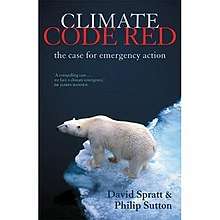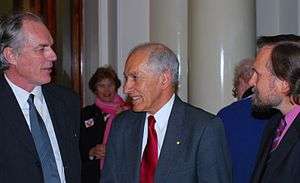Climate Code Red
Climate Code Red: The Case for Emergency Action is a 2008 book which presents scientific evidence that the global warming crisis is worse than official reports and national governments have so far indicated. The book argues that we are facing a "sustainability emergency" that requires a clear break from business-as-usual politics. The authors explain that emergency action to address climate change is not so much a radical idea as an indispensable course we must embark upon.[1] Climate Code Red draws heavily on the work of a large number of climate scientists, including James E. Hansen.[2]
 | |
| Author | David Spratt, Philip Sutton |
|---|---|
| Country | Australia |
| Subject | Climate change |
| Publisher | Scribe Publications |
Publication date | 2008 |
| Pages | 304 pp |
| ISBN | 1-921372-20-6 |
| OCLC | 243605472 |

General
The key themes of Climate Code Red are:
- "Our goal is a safe-climate future – we have no right to bargain away species or human lives."
- "We are facing rapid warming impacts: the danger is immediate, not just in the future."
- "For a safe climate future, we must take action now to stop emissions and to cool the earth."
- "Plan a large-scale transition to a post-carbon economy and society."
- "Recognise a climate and sustainability emergency, because we need to move at a pace far beyond business and politics as usual".[3]
Co-author David Spratt is a Melbourne businessman, climate-policy analyst, and co-founder of the Carbon Equity network, and director of the Breakthrough - National Centre for Climate Restoration.[4] Co-author Philip Sutton is convener of the Greenleap Strategic Institute and Assistant Convenor of the Climate Emergency Network.[5]
The book was launched by the Governor of Victoria, Professor David de Kretser in Parliament House in Melbourne, Victoria, on July 17, 2008.[6]
See also
References
- Code Red: The Book Archived 2008-07-19 at the Wayback Machine
- The Hansen Challenge Archived 2008-07-19 at the Wayback Machine
- Key themes Archived 2008-07-19 at the Wayback Machine
- "Climate change an 'existential security risk' to Australia, Senate inquiry says". The Guardian. 2018.
- "Climate Code Red: the Case for Emergency Action". Archived from the original on 2008-07-10. Retrieved 2008-06-26.
- Climate code red, Greenlivingpedia
External links
- Official website
- The Case for a Sustainability Emergency: Philip Sutton interview (audio) - The Reality Report
- The Case for a Sustainability Emergency: Philip Sutton interview (text) - Energy Bulletin
- Morton, Adam (2008-07-17). "Code red: Climate skating on thin ice, authors say". Melbourne: The Age.
- Alexandra De Blas (August–September 2008). "Climate Code Red: The Case for Emergency Action". ECOS (144): 12–4.
- Article on "Climate Code Red" by professor of politics Robert Manne, August 2008, The Monthly
- "Middle of the road ... towards a cliff". The Age. 2008-08-07.
- Coming clean on 'nice' coal
- Review of Climate Code Red: Energy Bulletin